Finance Management Report: HMS plc Investment in Turkey Analysis
VerifiedAdded on 2022/09/08
|15
|3667
|23
Report
AI Summary
This report examines Hatfield Manufacturing Systems plc (HMS plc)'s proposal to invest in Turkey, considering the country's favorable environment for manufacturing and its growing automotive and aerospace sectors. The report highlights the importance of evaluating currency risk in international business, particularly given Turkey's economic volatility and potential exposure to exchange rate fluctuations. It delves into the complexities of the foreign exchange market, the impact of currency fluctuations on commercial transactions, and the need for effective hedging strategies. The analysis includes financial data, such as CPI and exchange rates, to assess the investment's viability. The report also explores the challenges of business valuation in a global context, the assessment of investment risks, and the valuation of financial instruments. Furthermore, it addresses the volatility effects on the project and the impact of speculative capital flows on emerging markets. Overall, the report emphasizes the necessity of incorporating currency risk as a critical factor in evaluating the effectiveness of commercial transactions and investment decisions in the international arena.
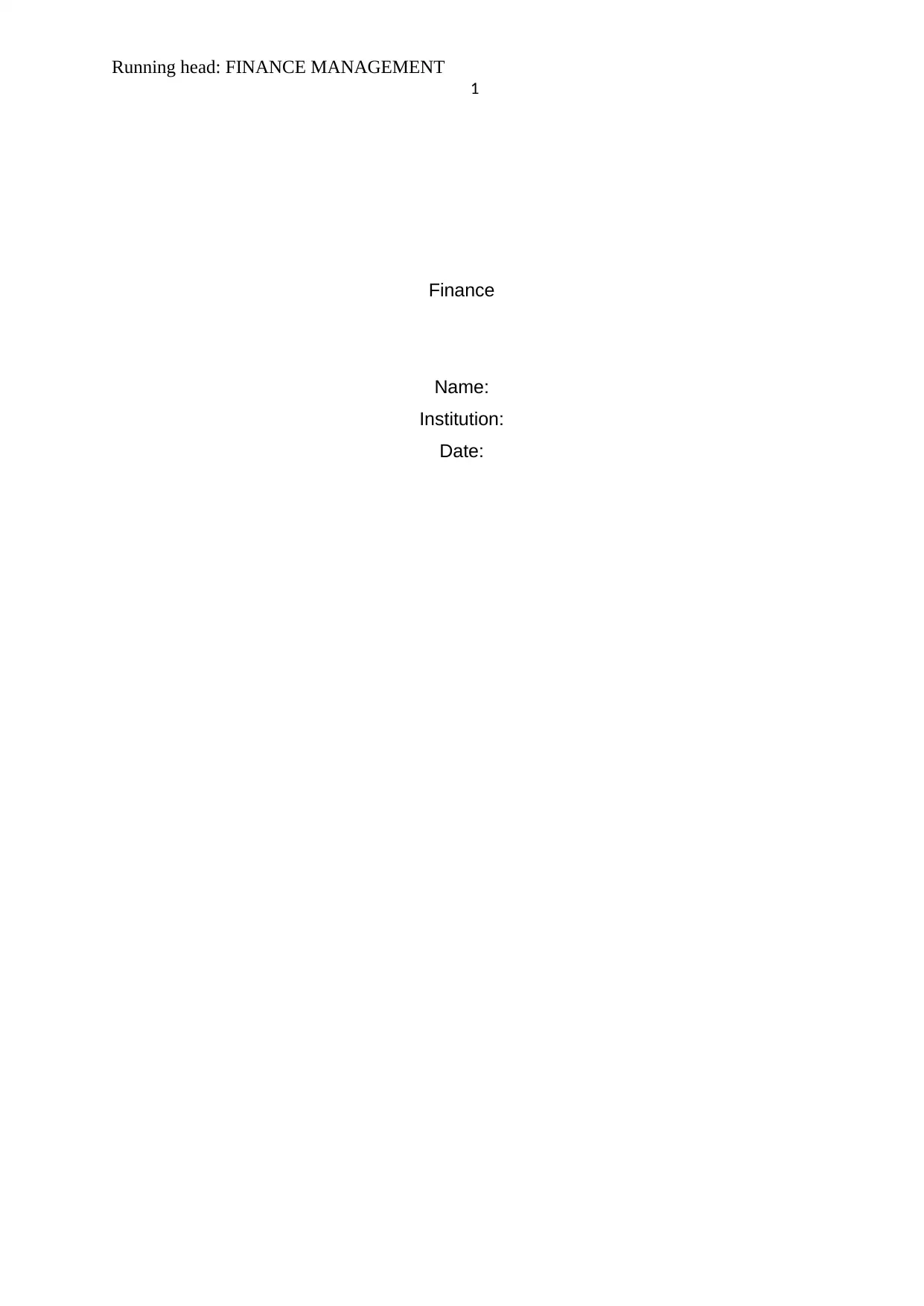
Running head: FINANCE MANAGEMENT
1
Finance
Name:
Institution:
Date:
1
Finance
Name:
Institution:
Date:
Paraphrase This Document
Need a fresh take? Get an instant paraphrase of this document with our AI Paraphraser
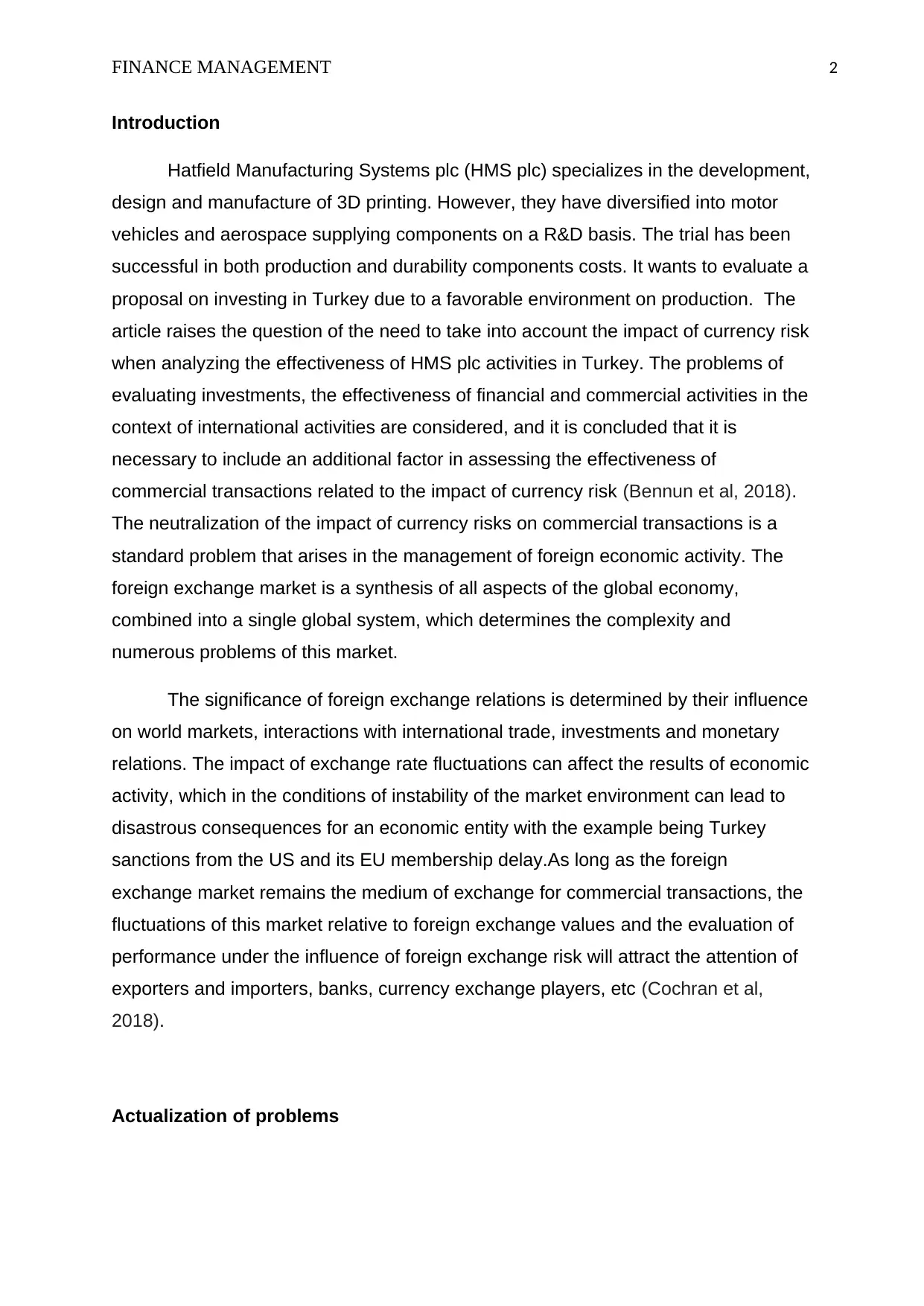
FINANCE MANAGEMENT 2
Introduction
Hatfield Manufacturing Systems plc (HMS plc) specializes in the development,
design and manufacture of 3D printing. However, they have diversified into motor
vehicles and aerospace supplying components on a R&D basis. The trial has been
successful in both production and durability components costs. It wants to evaluate a
proposal on investing in Turkey due to a favorable environment on production. The
article raises the question of the need to take into account the impact of currency risk
when analyzing the effectiveness of HMS plc activities in Turkey. The problems of
evaluating investments, the effectiveness of financial and commercial activities in the
context of international activities are considered, and it is concluded that it is
necessary to include an additional factor in assessing the effectiveness of
commercial transactions related to the impact of currency risk (Bennun et al, 2018).
The neutralization of the impact of currency risks on commercial transactions is a
standard problem that arises in the management of foreign economic activity. The
foreign exchange market is a synthesis of all aspects of the global economy,
combined into a single global system, which determines the complexity and
numerous problems of this market.
The significance of foreign exchange relations is determined by their influence
on world markets, interactions with international trade, investments and monetary
relations. The impact of exchange rate fluctuations can affect the results of economic
activity, which in the conditions of instability of the market environment can lead to
disastrous consequences for an economic entity with the example being Turkey
sanctions from the US and its EU membership delay.As long as the foreign
exchange market remains the medium of exchange for commercial transactions, the
fluctuations of this market relative to foreign exchange values and the evaluation of
performance under the influence of foreign exchange risk will attract the attention of
exporters and importers, banks, currency exchange players, etc (Cochran et al,
2018).
Actualization of problems
Introduction
Hatfield Manufacturing Systems plc (HMS plc) specializes in the development,
design and manufacture of 3D printing. However, they have diversified into motor
vehicles and aerospace supplying components on a R&D basis. The trial has been
successful in both production and durability components costs. It wants to evaluate a
proposal on investing in Turkey due to a favorable environment on production. The
article raises the question of the need to take into account the impact of currency risk
when analyzing the effectiveness of HMS plc activities in Turkey. The problems of
evaluating investments, the effectiveness of financial and commercial activities in the
context of international activities are considered, and it is concluded that it is
necessary to include an additional factor in assessing the effectiveness of
commercial transactions related to the impact of currency risk (Bennun et al, 2018).
The neutralization of the impact of currency risks on commercial transactions is a
standard problem that arises in the management of foreign economic activity. The
foreign exchange market is a synthesis of all aspects of the global economy,
combined into a single global system, which determines the complexity and
numerous problems of this market.
The significance of foreign exchange relations is determined by their influence
on world markets, interactions with international trade, investments and monetary
relations. The impact of exchange rate fluctuations can affect the results of economic
activity, which in the conditions of instability of the market environment can lead to
disastrous consequences for an economic entity with the example being Turkey
sanctions from the US and its EU membership delay.As long as the foreign
exchange market remains the medium of exchange for commercial transactions, the
fluctuations of this market relative to foreign exchange values and the evaluation of
performance under the influence of foreign exchange risk will attract the attention of
exporters and importers, banks, currency exchange players, etc (Cochran et al,
2018).
Actualization of problems
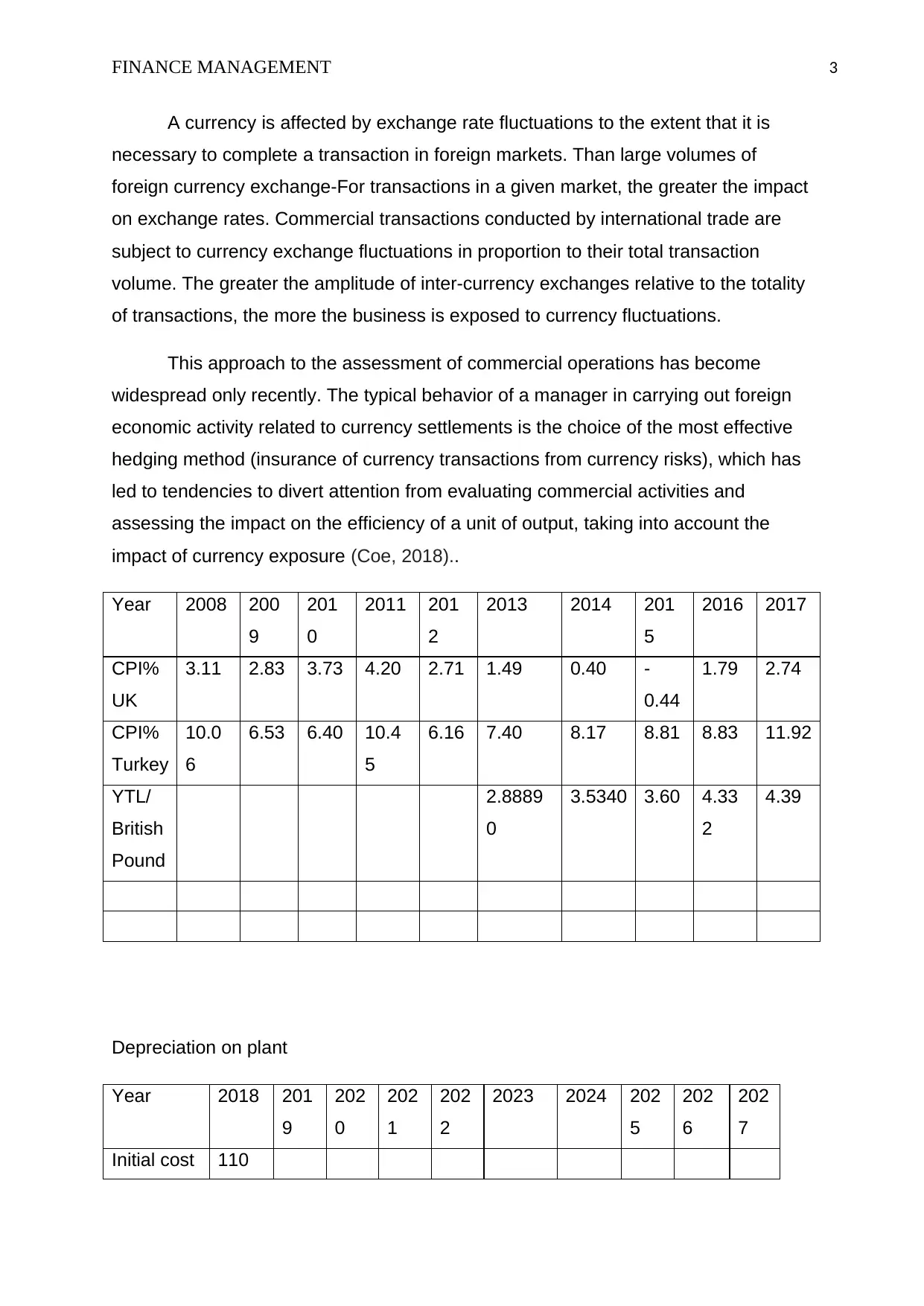
FINANCE MANAGEMENT 3
A currency is affected by exchange rate fluctuations to the extent that it is
necessary to complete a transaction in foreign markets. Than large volumes of
foreign currency exchange-For transactions in a given market, the greater the impact
on exchange rates. Commercial transactions conducted by international trade are
subject to currency exchange fluctuations in proportion to their total transaction
volume. The greater the amplitude of inter-currency exchanges relative to the totality
of transactions, the more the business is exposed to currency fluctuations.
This approach to the assessment of commercial operations has become
widespread only recently. The typical behavior of a manager in carrying out foreign
economic activity related to currency settlements is the choice of the most effective
hedging method (insurance of currency transactions from currency risks), which has
led to tendencies to divert attention from evaluating commercial activities and
assessing the impact on the efficiency of a unit of output, taking into account the
impact of currency exposure (Coe, 2018)..
Year 2008 200
9
201
0
2011 201
2
2013 2014 201
5
2016 2017
CPI%
UK
3.11 2.83 3.73 4.20 2.71 1.49 0.40 -
0.44
1.79 2.74
CPI%
Turkey
10.0
6
6.53 6.40 10.4
5
6.16 7.40 8.17 8.81 8.83 11.92
YTL/
British
Pound
2.8889
0
3.5340 3.60 4.33
2
4.39
Depreciation on plant
Year 2018 201
9
202
0
202
1
202
2
2023 2024 202
5
202
6
202
7
Initial cost 110
A currency is affected by exchange rate fluctuations to the extent that it is
necessary to complete a transaction in foreign markets. Than large volumes of
foreign currency exchange-For transactions in a given market, the greater the impact
on exchange rates. Commercial transactions conducted by international trade are
subject to currency exchange fluctuations in proportion to their total transaction
volume. The greater the amplitude of inter-currency exchanges relative to the totality
of transactions, the more the business is exposed to currency fluctuations.
This approach to the assessment of commercial operations has become
widespread only recently. The typical behavior of a manager in carrying out foreign
economic activity related to currency settlements is the choice of the most effective
hedging method (insurance of currency transactions from currency risks), which has
led to tendencies to divert attention from evaluating commercial activities and
assessing the impact on the efficiency of a unit of output, taking into account the
impact of currency exposure (Coe, 2018)..
Year 2008 200
9
201
0
2011 201
2
2013 2014 201
5
2016 2017
CPI%
UK
3.11 2.83 3.73 4.20 2.71 1.49 0.40 -
0.44
1.79 2.74
CPI%
Turkey
10.0
6
6.53 6.40 10.4
5
6.16 7.40 8.17 8.81 8.83 11.92
YTL/
British
Pound
2.8889
0
3.5340 3.60 4.33
2
4.39
Depreciation on plant
Year 2018 201
9
202
0
202
1
202
2
2023 2024 202
5
202
6
202
7
Initial cost 110
⊘ This is a preview!⊘
Do you want full access?
Subscribe today to unlock all pages.

Trusted by 1+ million students worldwide
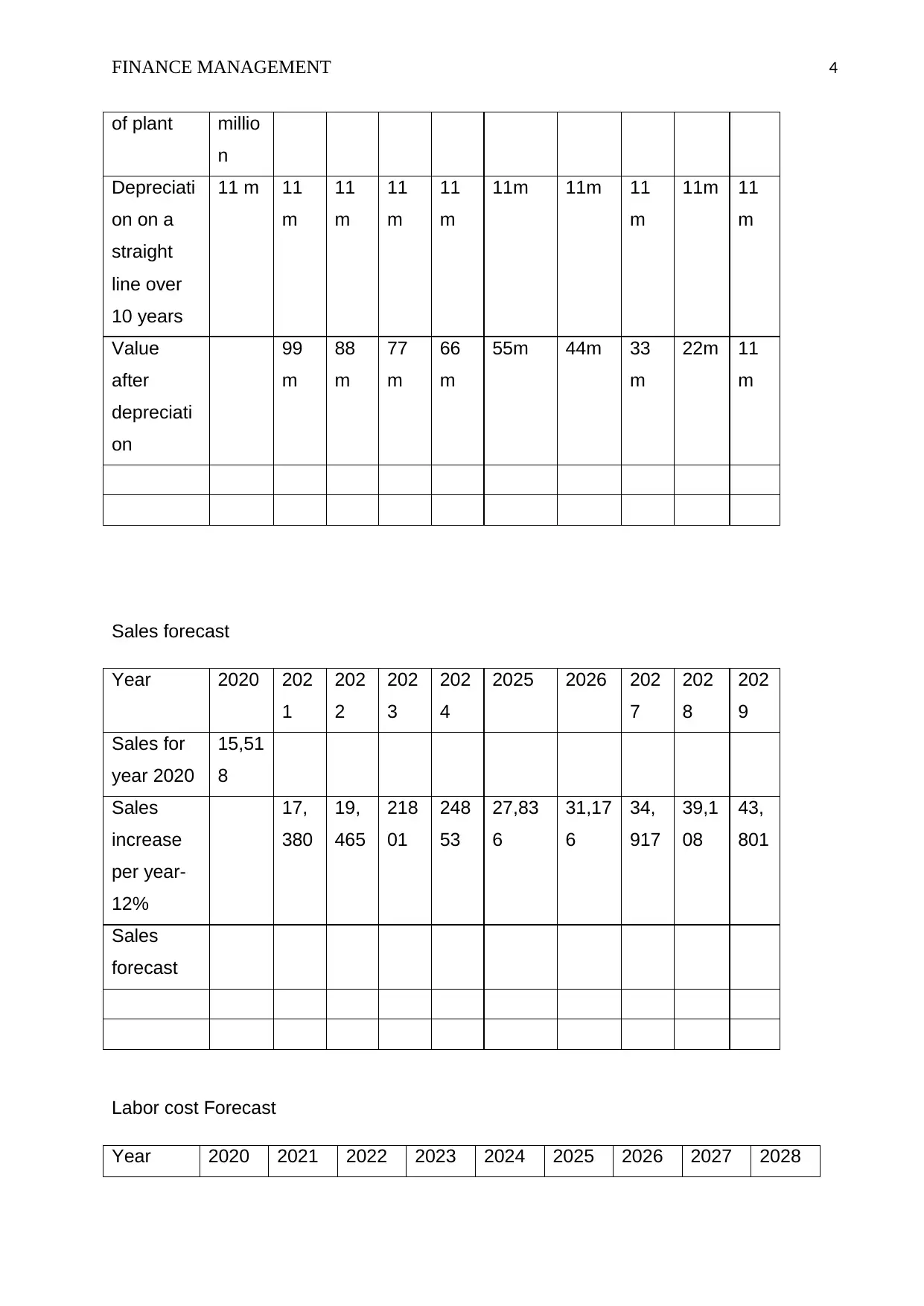
FINANCE MANAGEMENT 4
of plant millio
n
Depreciati
on on a
straight
line over
10 years
11 m 11
m
11
m
11
m
11
m
11m 11m 11
m
11m 11
m
Value
after
depreciati
on
99
m
88
m
77
m
66
m
55m 44m 33
m
22m 11
m
Sales forecast
Year 2020 202
1
202
2
202
3
202
4
2025 2026 202
7
202
8
202
9
Sales for
year 2020
15,51
8
Sales
increase
per year-
12%
17,
380
19,
465
218
01
248
53
27,83
6
31,17
6
34,
917
39,1
08
43,
801
Sales
forecast
Labor cost Forecast
Year 2020 2021 2022 2023 2024 2025 2026 2027 2028
of plant millio
n
Depreciati
on on a
straight
line over
10 years
11 m 11
m
11
m
11
m
11
m
11m 11m 11
m
11m 11
m
Value
after
depreciati
on
99
m
88
m
77
m
66
m
55m 44m 33
m
22m 11
m
Sales forecast
Year 2020 202
1
202
2
202
3
202
4
2025 2026 202
7
202
8
202
9
Sales for
year 2020
15,51
8
Sales
increase
per year-
12%
17,
380
19,
465
218
01
248
53
27,83
6
31,17
6
34,
917
39,1
08
43,
801
Sales
forecast
Labor cost Forecast
Year 2020 2021 2022 2023 2024 2025 2026 2027 2028
Paraphrase This Document
Need a fresh take? Get an instant paraphrase of this document with our AI Paraphraser
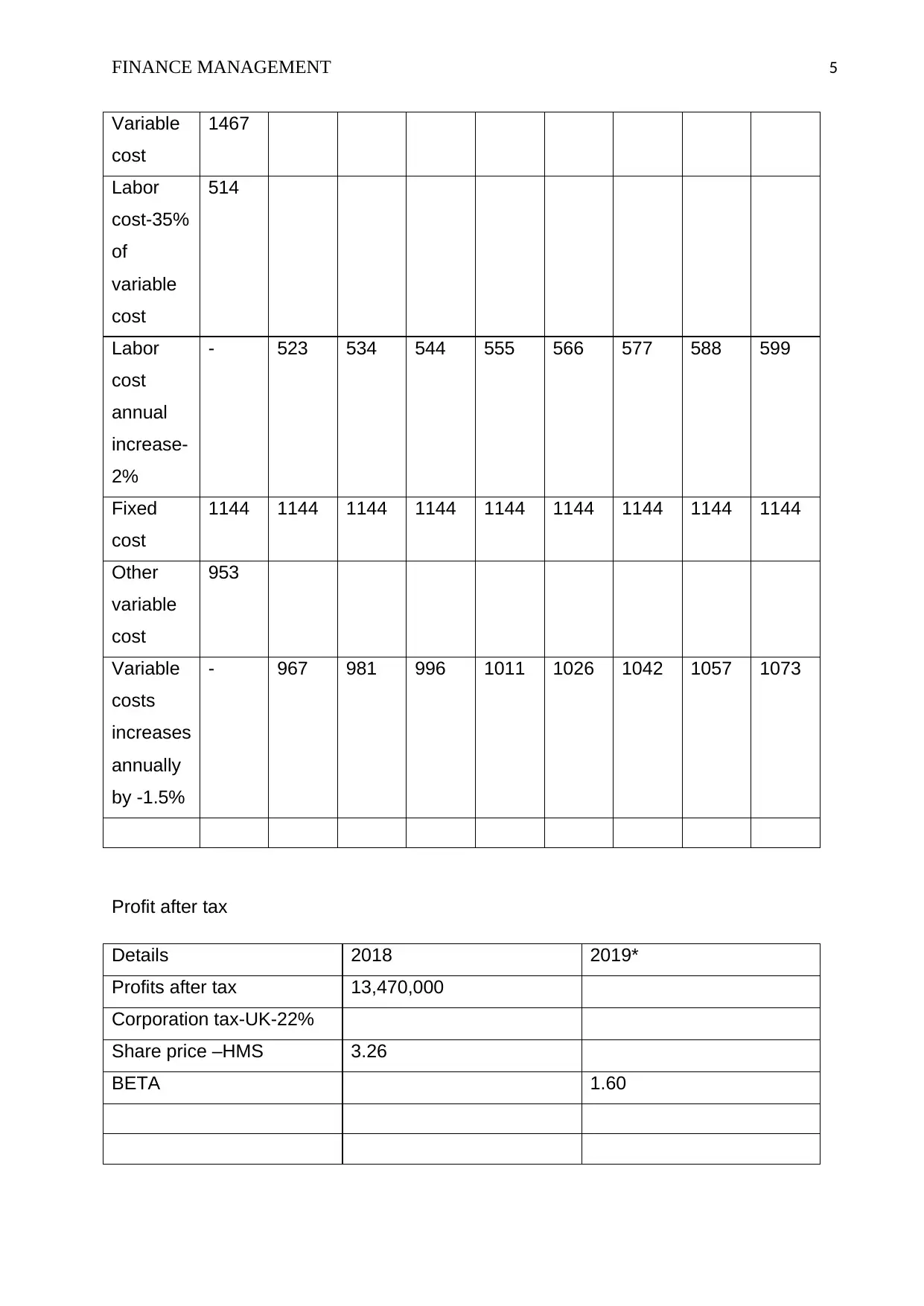
FINANCE MANAGEMENT 5
Variable
cost
1467
Labor
cost-35%
of
variable
cost
514
Labor
cost
annual
increase-
2%
- 523 534 544 555 566 577 588 599
Fixed
cost
1144 1144 1144 1144 1144 1144 1144 1144 1144
Other
variable
cost
953
Variable
costs
increases
annually
by -1.5%
- 967 981 996 1011 1026 1042 1057 1073
Profit after tax
Details 2018 2019*
Profits after tax 13,470,000
Corporation tax-UK-22%
Share price –HMS 3.26
BETA 1.60
Variable
cost
1467
Labor
cost-35%
of
variable
cost
514
Labor
cost
annual
increase-
2%
- 523 534 544 555 566 577 588 599
Fixed
cost
1144 1144 1144 1144 1144 1144 1144 1144 1144
Other
variable
cost
953
Variable
costs
increases
annually
by -1.5%
- 967 981 996 1011 1026 1042 1057 1073
Profit after tax
Details 2018 2019*
Profits after tax 13,470,000
Corporation tax-UK-22%
Share price –HMS 3.26
BETA 1.60
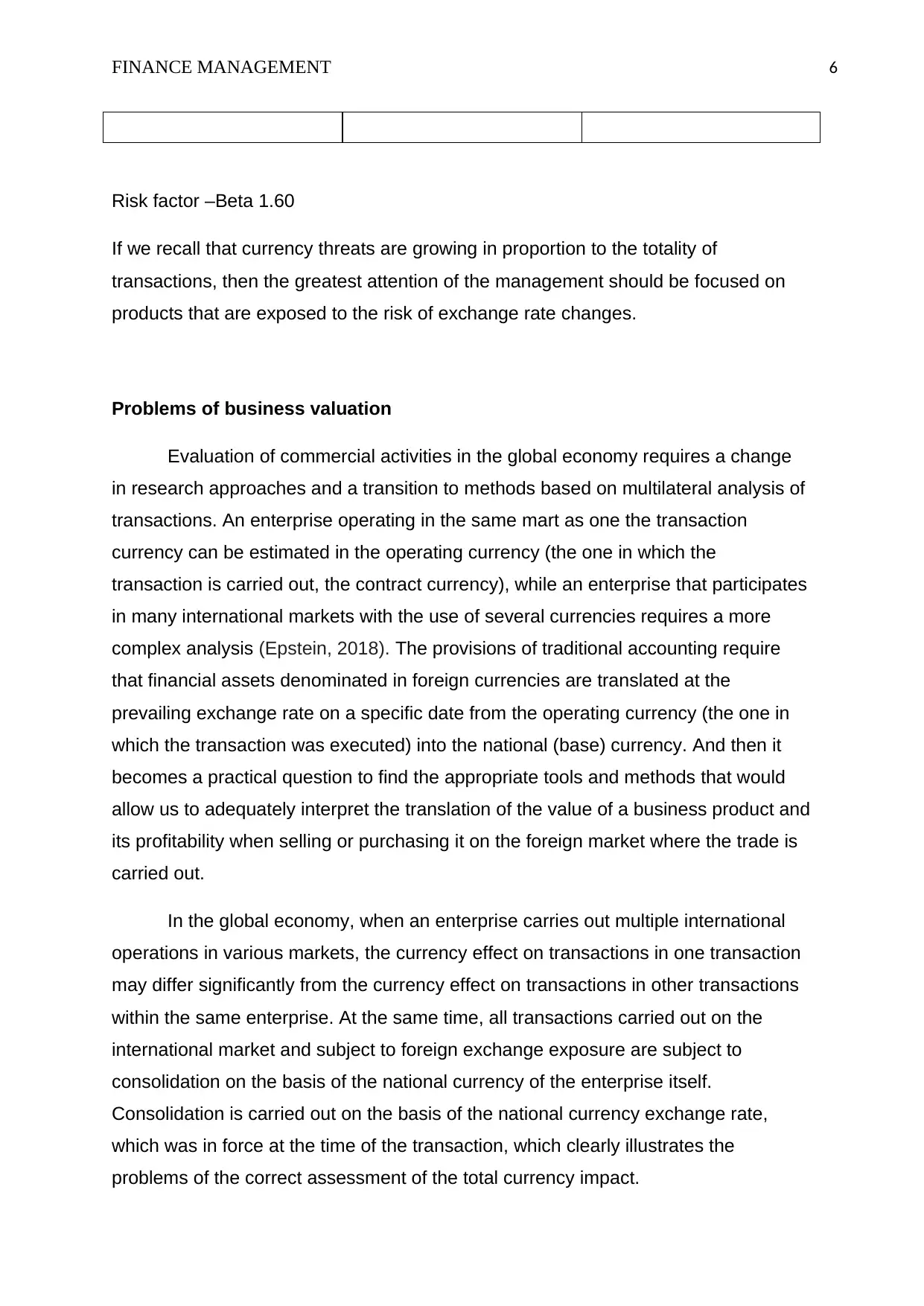
FINANCE MANAGEMENT 6
Risk factor –Beta 1.60
If we recall that currency threats are growing in proportion to the totality of
transactions, then the greatest attention of the management should be focused on
products that are exposed to the risk of exchange rate changes.
Problems of business valuation
Evaluation of commercial activities in the global economy requires a change
in research approaches and a transition to methods based on multilateral analysis of
transactions. An enterprise operating in the same mart as one the transaction
currency can be estimated in the operating currency (the one in which the
transaction is carried out, the contract currency), while an enterprise that participates
in many international markets with the use of several currencies requires a more
complex analysis (Epstein, 2018). The provisions of traditional accounting require
that financial assets denominated in foreign currencies are translated at the
prevailing exchange rate on a specific date from the operating currency (the one in
which the transaction was executed) into the national (base) currency. And then it
becomes a practical question to find the appropriate tools and methods that would
allow us to adequately interpret the translation of the value of a business product and
its profitability when selling or purchasing it on the foreign market where the trade is
carried out.
In the global economy, when an enterprise carries out multiple international
operations in various markets, the currency effect on transactions in one transaction
may differ significantly from the currency effect on transactions in other transactions
within the same enterprise. At the same time, all transactions carried out on the
international market and subject to foreign exchange exposure are subject to
consolidation on the basis of the national currency of the enterprise itself.
Consolidation is carried out on the basis of the national currency exchange rate,
which was in force at the time of the transaction, which clearly illustrates the
problems of the correct assessment of the total currency impact.
Risk factor –Beta 1.60
If we recall that currency threats are growing in proportion to the totality of
transactions, then the greatest attention of the management should be focused on
products that are exposed to the risk of exchange rate changes.
Problems of business valuation
Evaluation of commercial activities in the global economy requires a change
in research approaches and a transition to methods based on multilateral analysis of
transactions. An enterprise operating in the same mart as one the transaction
currency can be estimated in the operating currency (the one in which the
transaction is carried out, the contract currency), while an enterprise that participates
in many international markets with the use of several currencies requires a more
complex analysis (Epstein, 2018). The provisions of traditional accounting require
that financial assets denominated in foreign currencies are translated at the
prevailing exchange rate on a specific date from the operating currency (the one in
which the transaction was executed) into the national (base) currency. And then it
becomes a practical question to find the appropriate tools and methods that would
allow us to adequately interpret the translation of the value of a business product and
its profitability when selling or purchasing it on the foreign market where the trade is
carried out.
In the global economy, when an enterprise carries out multiple international
operations in various markets, the currency effect on transactions in one transaction
may differ significantly from the currency effect on transactions in other transactions
within the same enterprise. At the same time, all transactions carried out on the
international market and subject to foreign exchange exposure are subject to
consolidation on the basis of the national currency of the enterprise itself.
Consolidation is carried out on the basis of the national currency exchange rate,
which was in force at the time of the transaction, which clearly illustrates the
problems of the correct assessment of the total currency impact.
⊘ This is a preview!⊘
Do you want full access?
Subscribe today to unlock all pages.

Trusted by 1+ million students worldwide
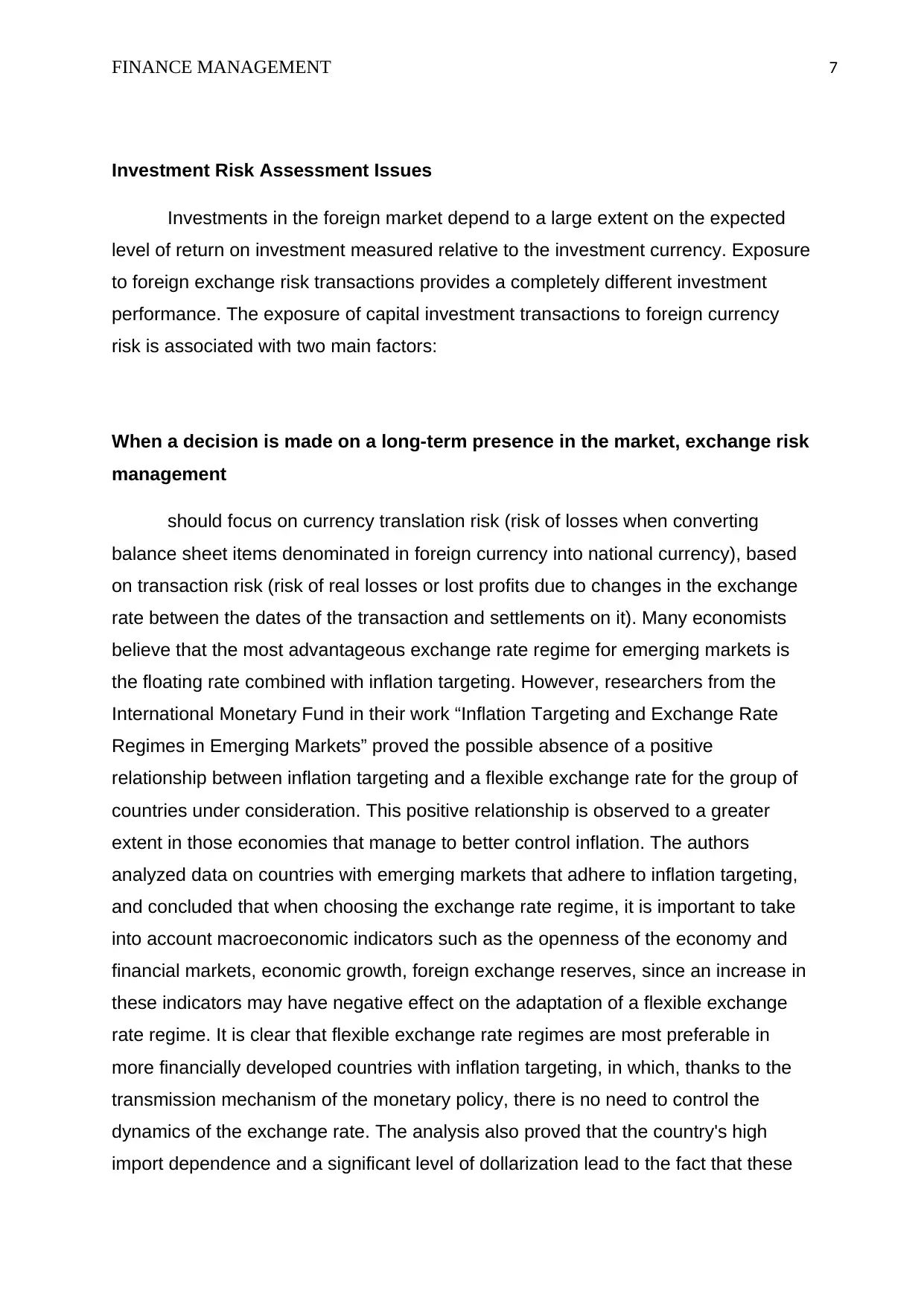
FINANCE MANAGEMENT 7
Investment Risk Assessment Issues
Investments in the foreign market depend to a large extent on the expected
level of return on investment measured relative to the investment currency. Exposure
to foreign exchange risk transactions provides a completely different investment
performance. The exposure of capital investment transactions to foreign currency
risk is associated with two main factors:
When a decision is made on a long-term presence in the market, exchange risk
management
should focus on currency translation risk (risk of losses when converting
balance sheet items denominated in foreign currency into national currency), based
on transaction risk (risk of real losses or lost profits due to changes in the exchange
rate between the dates of the transaction and settlements on it). Many economists
believe that the most advantageous exchange rate regime for emerging markets is
the floating rate combined with inflation targeting. However, researchers from the
International Monetary Fund in their work “Inflation Targeting and Exchange Rate
Regimes in Emerging Markets” proved the possible absence of a positive
relationship between inflation targeting and a flexible exchange rate for the group of
countries under consideration. This positive relationship is observed to a greater
extent in those economies that manage to better control inflation. The authors
analyzed data on countries with emerging markets that adhere to inflation targeting,
and concluded that when choosing the exchange rate regime, it is important to take
into account macroeconomic indicators such as the openness of the economy and
financial markets, economic growth, foreign exchange reserves, since an increase in
these indicators may have negative effect on the adaptation of a flexible exchange
rate regime. It is clear that flexible exchange rate regimes are most preferable in
more financially developed countries with inflation targeting, in which, thanks to the
transmission mechanism of the monetary policy, there is no need to control the
dynamics of the exchange rate. The analysis also proved that the country's high
import dependence and a significant level of dollarization lead to the fact that these
Investment Risk Assessment Issues
Investments in the foreign market depend to a large extent on the expected
level of return on investment measured relative to the investment currency. Exposure
to foreign exchange risk transactions provides a completely different investment
performance. The exposure of capital investment transactions to foreign currency
risk is associated with two main factors:
When a decision is made on a long-term presence in the market, exchange risk
management
should focus on currency translation risk (risk of losses when converting
balance sheet items denominated in foreign currency into national currency), based
on transaction risk (risk of real losses or lost profits due to changes in the exchange
rate between the dates of the transaction and settlements on it). Many economists
believe that the most advantageous exchange rate regime for emerging markets is
the floating rate combined with inflation targeting. However, researchers from the
International Monetary Fund in their work “Inflation Targeting and Exchange Rate
Regimes in Emerging Markets” proved the possible absence of a positive
relationship between inflation targeting and a flexible exchange rate for the group of
countries under consideration. This positive relationship is observed to a greater
extent in those economies that manage to better control inflation. The authors
analyzed data on countries with emerging markets that adhere to inflation targeting,
and concluded that when choosing the exchange rate regime, it is important to take
into account macroeconomic indicators such as the openness of the economy and
financial markets, economic growth, foreign exchange reserves, since an increase in
these indicators may have negative effect on the adaptation of a flexible exchange
rate regime. It is clear that flexible exchange rate regimes are most preferable in
more financially developed countries with inflation targeting, in which, thanks to the
transmission mechanism of the monetary policy, there is no need to control the
dynamics of the exchange rate. The analysis also proved that the country's high
import dependence and a significant level of dollarization lead to the fact that these
Paraphrase This Document
Need a fresh take? Get an instant paraphrase of this document with our AI Paraphraser
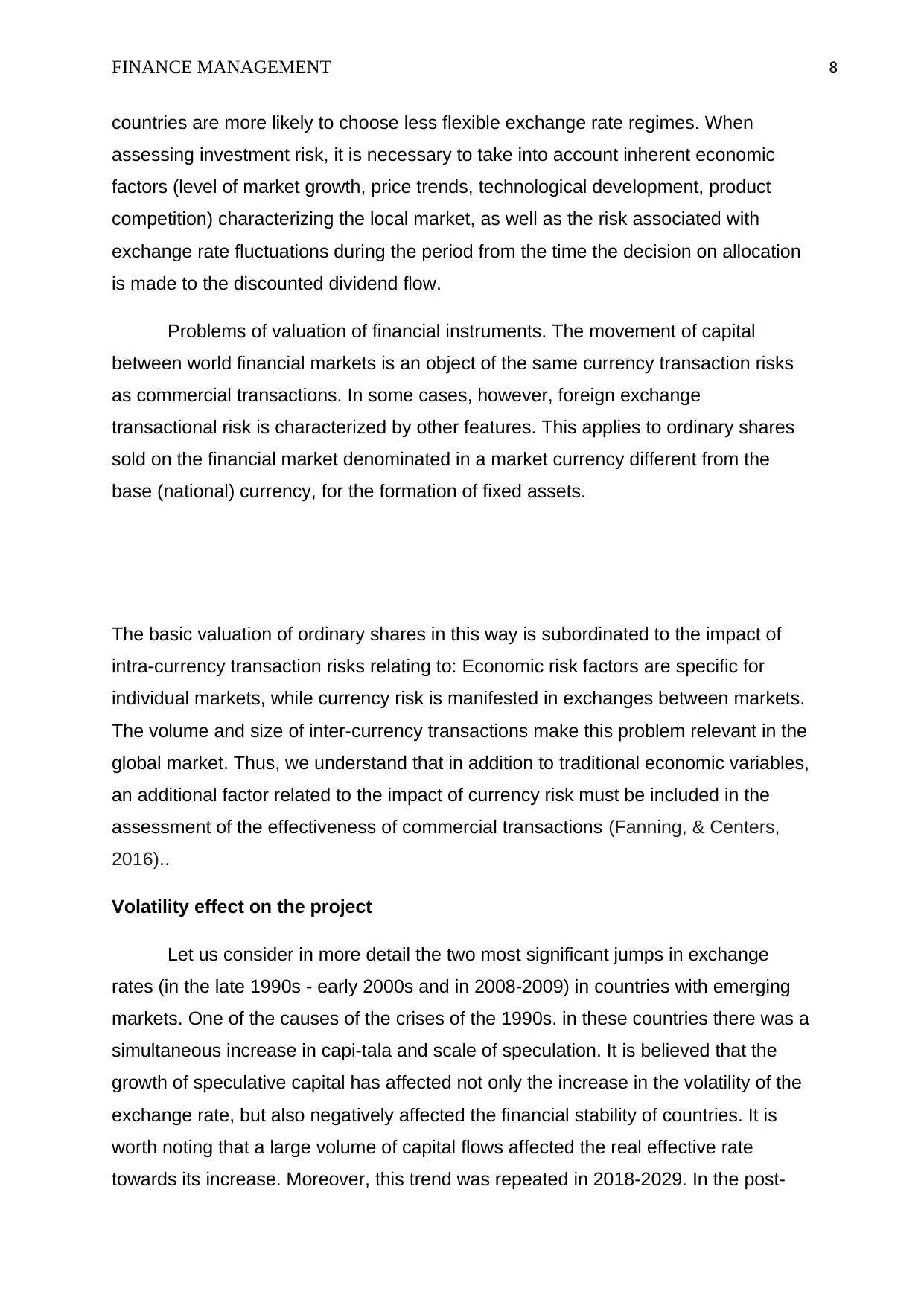
FINANCE MANAGEMENT 8
countries are more likely to choose less flexible exchange rate regimes. When
assessing investment risk, it is necessary to take into account inherent economic
factors (level of market growth, price trends, technological development, product
competition) characterizing the local market, as well as the risk associated with
exchange rate fluctuations during the period from the time the decision on allocation
is made to the discounted dividend flow.
Problems of valuation of financial instruments. The movement of capital
between world financial markets is an object of the same currency transaction risks
as commercial transactions. In some cases, however, foreign exchange
transactional risk is characterized by other features. This applies to ordinary shares
sold on the financial market denominated in a market currency different from the
base (national) currency, for the formation of fixed assets.
The basic valuation of ordinary shares in this way is subordinated to the impact of
intra-currency transaction risks relating to: Economic risk factors are specific for
individual markets, while currency risk is manifested in exchanges between markets.
The volume and size of inter-currency transactions make this problem relevant in the
global market. Thus, we understand that in addition to traditional economic variables,
an additional factor related to the impact of currency risk must be included in the
assessment of the effectiveness of commercial transactions (Fanning, & Centers,
2016)..
Volatility effect on the project
Let us consider in more detail the two most significant jumps in exchange
rates (in the late 1990s - early 2000s and in 2008-2009) in countries with emerging
markets. One of the causes of the crises of the 1990s. in these countries there was a
simultaneous increase in capi-tala and scale of speculation. It is believed that the
growth of speculative capital has affected not only the increase in the volatility of the
exchange rate, but also negatively affected the financial stability of countries. It is
worth noting that a large volume of capital flows affected the real effective rate
towards its increase. Moreover, this trend was repeated in 2018-2029. In the post-
countries are more likely to choose less flexible exchange rate regimes. When
assessing investment risk, it is necessary to take into account inherent economic
factors (level of market growth, price trends, technological development, product
competition) characterizing the local market, as well as the risk associated with
exchange rate fluctuations during the period from the time the decision on allocation
is made to the discounted dividend flow.
Problems of valuation of financial instruments. The movement of capital
between world financial markets is an object of the same currency transaction risks
as commercial transactions. In some cases, however, foreign exchange
transactional risk is characterized by other features. This applies to ordinary shares
sold on the financial market denominated in a market currency different from the
base (national) currency, for the formation of fixed assets.
The basic valuation of ordinary shares in this way is subordinated to the impact of
intra-currency transaction risks relating to: Economic risk factors are specific for
individual markets, while currency risk is manifested in exchanges between markets.
The volume and size of inter-currency transactions make this problem relevant in the
global market. Thus, we understand that in addition to traditional economic variables,
an additional factor related to the impact of currency risk must be included in the
assessment of the effectiveness of commercial transactions (Fanning, & Centers,
2016)..
Volatility effect on the project
Let us consider in more detail the two most significant jumps in exchange
rates (in the late 1990s - early 2000s and in 2008-2009) in countries with emerging
markets. One of the causes of the crises of the 1990s. in these countries there was a
simultaneous increase in capi-tala and scale of speculation. It is believed that the
growth of speculative capital has affected not only the increase in the volatility of the
exchange rate, but also negatively affected the financial stability of countries. It is
worth noting that a large volume of capital flows affected the real effective rate
towards its increase. Moreover, this trend was repeated in 2018-2029. In the post-
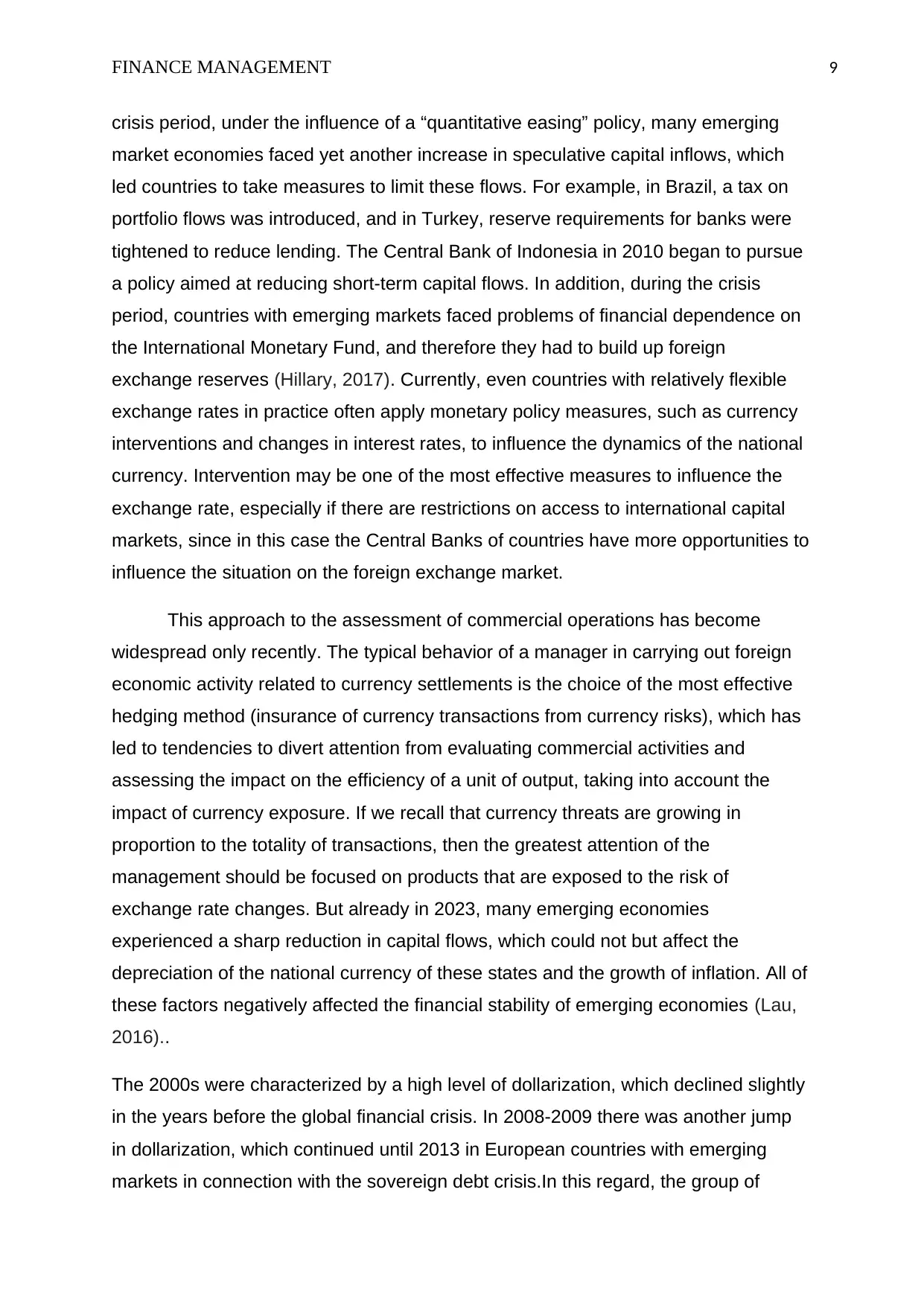
FINANCE MANAGEMENT 9
crisis period, under the influence of a “quantitative easing” policy, many emerging
market economies faced yet another increase in speculative capital inflows, which
led countries to take measures to limit these flows. For example, in Brazil, a tax on
portfolio flows was introduced, and in Turkey, reserve requirements for banks were
tightened to reduce lending. The Central Bank of Indonesia in 2010 began to pursue
a policy aimed at reducing short-term capital flows. In addition, during the crisis
period, countries with emerging markets faced problems of financial dependence on
the International Monetary Fund, and therefore they had to build up foreign
exchange reserves (Hillary, 2017). Currently, even countries with relatively flexible
exchange rates in practice often apply monetary policy measures, such as currency
interventions and changes in interest rates, to influence the dynamics of the national
currency. Intervention may be one of the most effective measures to influence the
exchange rate, especially if there are restrictions on access to international capital
markets, since in this case the Central Banks of countries have more opportunities to
influence the situation on the foreign exchange market.
This approach to the assessment of commercial operations has become
widespread only recently. The typical behavior of a manager in carrying out foreign
economic activity related to currency settlements is the choice of the most effective
hedging method (insurance of currency transactions from currency risks), which has
led to tendencies to divert attention from evaluating commercial activities and
assessing the impact on the efficiency of a unit of output, taking into account the
impact of currency exposure. If we recall that currency threats are growing in
proportion to the totality of transactions, then the greatest attention of the
management should be focused on products that are exposed to the risk of
exchange rate changes. But already in 2023, many emerging economies
experienced a sharp reduction in capital flows, which could not but affect the
depreciation of the national currency of these states and the growth of inflation. All of
these factors negatively affected the financial stability of emerging economies (Lau,
2016)..
The 2000s were characterized by a high level of dollarization, which declined slightly
in the years before the global financial crisis. In 2008-2009 there was another jump
in dollarization, which continued until 2013 in European countries with emerging
markets in connection with the sovereign debt crisis.In this regard, the group of
crisis period, under the influence of a “quantitative easing” policy, many emerging
market economies faced yet another increase in speculative capital inflows, which
led countries to take measures to limit these flows. For example, in Brazil, a tax on
portfolio flows was introduced, and in Turkey, reserve requirements for banks were
tightened to reduce lending. The Central Bank of Indonesia in 2010 began to pursue
a policy aimed at reducing short-term capital flows. In addition, during the crisis
period, countries with emerging markets faced problems of financial dependence on
the International Monetary Fund, and therefore they had to build up foreign
exchange reserves (Hillary, 2017). Currently, even countries with relatively flexible
exchange rates in practice often apply monetary policy measures, such as currency
interventions and changes in interest rates, to influence the dynamics of the national
currency. Intervention may be one of the most effective measures to influence the
exchange rate, especially if there are restrictions on access to international capital
markets, since in this case the Central Banks of countries have more opportunities to
influence the situation on the foreign exchange market.
This approach to the assessment of commercial operations has become
widespread only recently. The typical behavior of a manager in carrying out foreign
economic activity related to currency settlements is the choice of the most effective
hedging method (insurance of currency transactions from currency risks), which has
led to tendencies to divert attention from evaluating commercial activities and
assessing the impact on the efficiency of a unit of output, taking into account the
impact of currency exposure. If we recall that currency threats are growing in
proportion to the totality of transactions, then the greatest attention of the
management should be focused on products that are exposed to the risk of
exchange rate changes. But already in 2023, many emerging economies
experienced a sharp reduction in capital flows, which could not but affect the
depreciation of the national currency of these states and the growth of inflation. All of
these factors negatively affected the financial stability of emerging economies (Lau,
2016)..
The 2000s were characterized by a high level of dollarization, which declined slightly
in the years before the global financial crisis. In 2008-2009 there was another jump
in dollarization, which continued until 2013 in European countries with emerging
markets in connection with the sovereign debt crisis.In this regard, the group of
⊘ This is a preview!⊘
Do you want full access?
Subscribe today to unlock all pages.

Trusted by 1+ million students worldwide
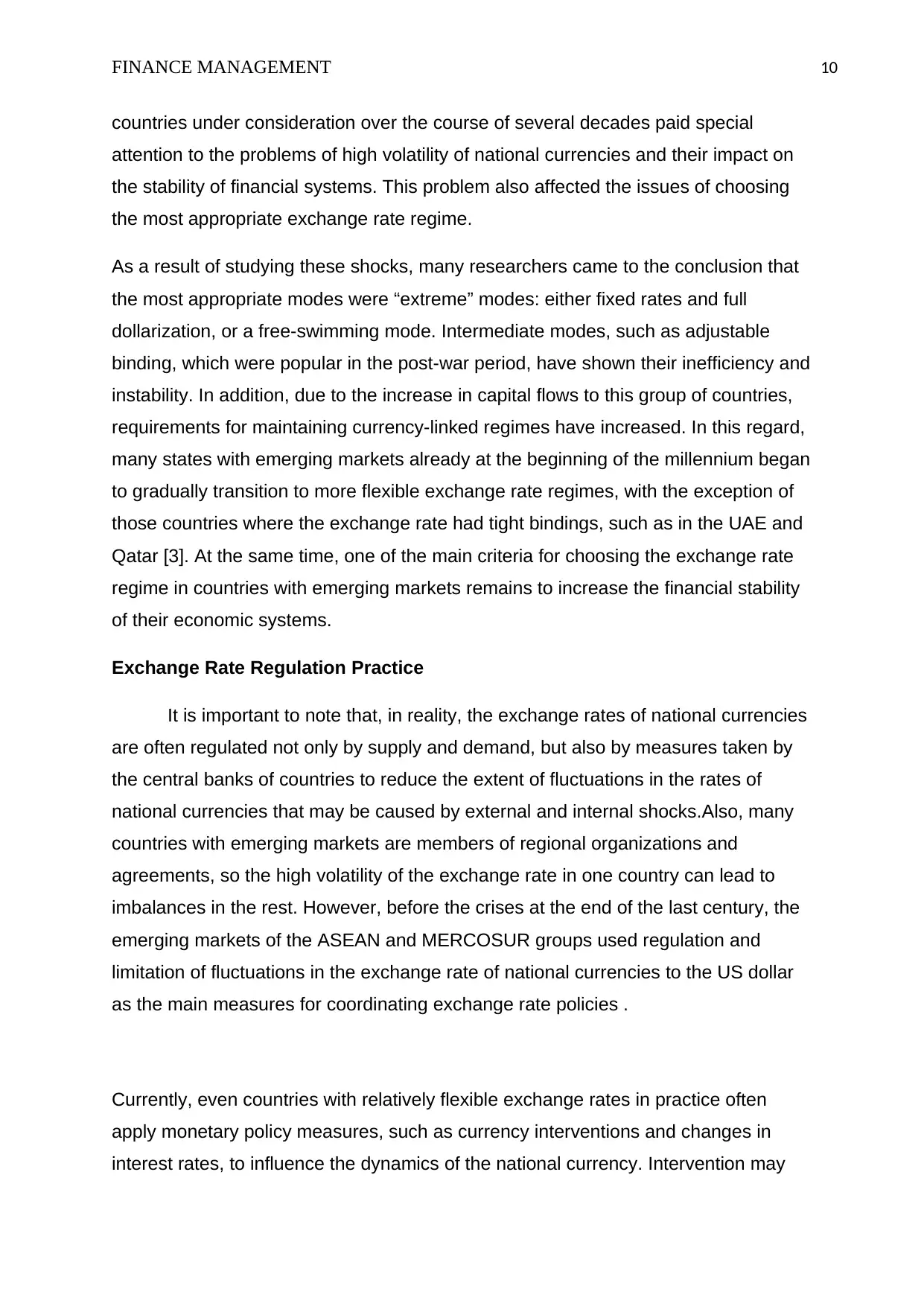
FINANCE MANAGEMENT 10
countries under consideration over the course of several decades paid special
attention to the problems of high volatility of national currencies and their impact on
the stability of financial systems. This problem also affected the issues of choosing
the most appropriate exchange rate regime.
As a result of studying these shocks, many researchers came to the conclusion that
the most appropriate modes were “extreme” modes: either fixed rates and full
dollarization, or a free-swimming mode. Intermediate modes, such as adjustable
binding, which were popular in the post-war period, have shown their inefficiency and
instability. In addition, due to the increase in capital flows to this group of countries,
requirements for maintaining currency-linked regimes have increased. In this regard,
many states with emerging markets already at the beginning of the millennium began
to gradually transition to more flexible exchange rate regimes, with the exception of
those countries where the exchange rate had tight bindings, such as in the UAE and
Qatar [3]. At the same time, one of the main criteria for choosing the exchange rate
regime in countries with emerging markets remains to increase the financial stability
of their economic systems.
Exchange Rate Regulation Practice
It is important to note that, in reality, the exchange rates of national currencies
are often regulated not only by supply and demand, but also by measures taken by
the central banks of countries to reduce the extent of fluctuations in the rates of
national currencies that may be caused by external and internal shocks.Also, many
countries with emerging markets are members of regional organizations and
agreements, so the high volatility of the exchange rate in one country can lead to
imbalances in the rest. However, before the crises at the end of the last century, the
emerging markets of the ASEAN and MERCOSUR groups used regulation and
limitation of fluctuations in the exchange rate of national currencies to the US dollar
as the main measures for coordinating exchange rate policies .
Currently, even countries with relatively flexible exchange rates in practice often
apply monetary policy measures, such as currency interventions and changes in
interest rates, to influence the dynamics of the national currency. Intervention may
countries under consideration over the course of several decades paid special
attention to the problems of high volatility of national currencies and their impact on
the stability of financial systems. This problem also affected the issues of choosing
the most appropriate exchange rate regime.
As a result of studying these shocks, many researchers came to the conclusion that
the most appropriate modes were “extreme” modes: either fixed rates and full
dollarization, or a free-swimming mode. Intermediate modes, such as adjustable
binding, which were popular in the post-war period, have shown their inefficiency and
instability. In addition, due to the increase in capital flows to this group of countries,
requirements for maintaining currency-linked regimes have increased. In this regard,
many states with emerging markets already at the beginning of the millennium began
to gradually transition to more flexible exchange rate regimes, with the exception of
those countries where the exchange rate had tight bindings, such as in the UAE and
Qatar [3]. At the same time, one of the main criteria for choosing the exchange rate
regime in countries with emerging markets remains to increase the financial stability
of their economic systems.
Exchange Rate Regulation Practice
It is important to note that, in reality, the exchange rates of national currencies
are often regulated not only by supply and demand, but also by measures taken by
the central banks of countries to reduce the extent of fluctuations in the rates of
national currencies that may be caused by external and internal shocks.Also, many
countries with emerging markets are members of regional organizations and
agreements, so the high volatility of the exchange rate in one country can lead to
imbalances in the rest. However, before the crises at the end of the last century, the
emerging markets of the ASEAN and MERCOSUR groups used regulation and
limitation of fluctuations in the exchange rate of national currencies to the US dollar
as the main measures for coordinating exchange rate policies .
Currently, even countries with relatively flexible exchange rates in practice often
apply monetary policy measures, such as currency interventions and changes in
interest rates, to influence the dynamics of the national currency. Intervention may
Paraphrase This Document
Need a fresh take? Get an instant paraphrase of this document with our AI Paraphraser
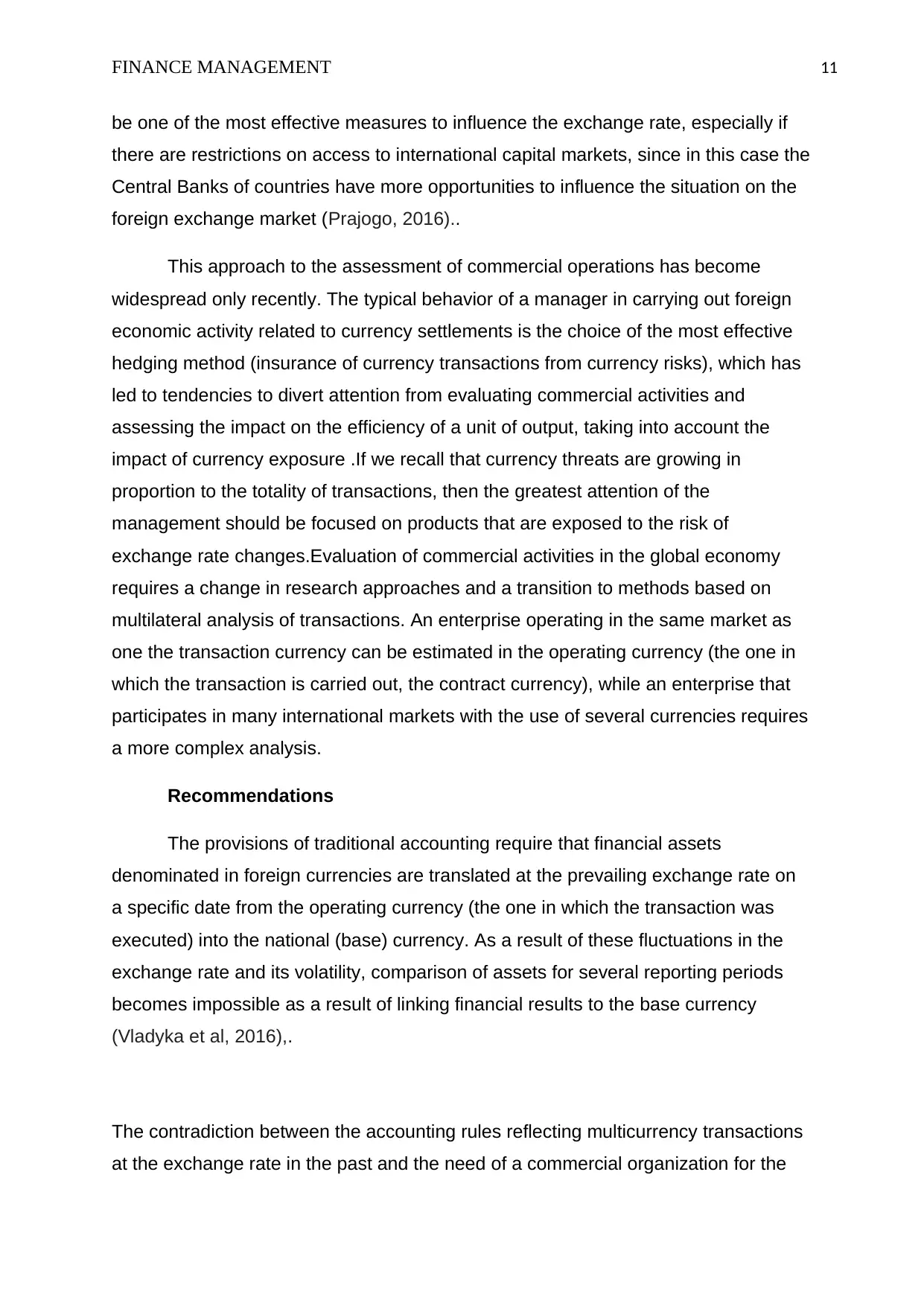
FINANCE MANAGEMENT 11
be one of the most effective measures to influence the exchange rate, especially if
there are restrictions on access to international capital markets, since in this case the
Central Banks of countries have more opportunities to influence the situation on the
foreign exchange market (Prajogo, 2016)..
This approach to the assessment of commercial operations has become
widespread only recently. The typical behavior of a manager in carrying out foreign
economic activity related to currency settlements is the choice of the most effective
hedging method (insurance of currency transactions from currency risks), which has
led to tendencies to divert attention from evaluating commercial activities and
assessing the impact on the efficiency of a unit of output, taking into account the
impact of currency exposure .If we recall that currency threats are growing in
proportion to the totality of transactions, then the greatest attention of the
management should be focused on products that are exposed to the risk of
exchange rate changes.Evaluation of commercial activities in the global economy
requires a change in research approaches and a transition to methods based on
multilateral analysis of transactions. An enterprise operating in the same market as
one the transaction currency can be estimated in the operating currency (the one in
which the transaction is carried out, the contract currency), while an enterprise that
participates in many international markets with the use of several currencies requires
a more complex analysis.
Recommendations
The provisions of traditional accounting require that financial assets
denominated in foreign currencies are translated at the prevailing exchange rate on
a specific date from the operating currency (the one in which the transaction was
executed) into the national (base) currency. As a result of these fluctuations in the
exchange rate and its volatility, comparison of assets for several reporting periods
becomes impossible as a result of linking financial results to the base currency
(Vladyka et al, 2016),.
The contradiction between the accounting rules reflecting multicurrency transactions
at the exchange rate in the past and the need of a commercial organization for the
be one of the most effective measures to influence the exchange rate, especially if
there are restrictions on access to international capital markets, since in this case the
Central Banks of countries have more opportunities to influence the situation on the
foreign exchange market (Prajogo, 2016)..
This approach to the assessment of commercial operations has become
widespread only recently. The typical behavior of a manager in carrying out foreign
economic activity related to currency settlements is the choice of the most effective
hedging method (insurance of currency transactions from currency risks), which has
led to tendencies to divert attention from evaluating commercial activities and
assessing the impact on the efficiency of a unit of output, taking into account the
impact of currency exposure .If we recall that currency threats are growing in
proportion to the totality of transactions, then the greatest attention of the
management should be focused on products that are exposed to the risk of
exchange rate changes.Evaluation of commercial activities in the global economy
requires a change in research approaches and a transition to methods based on
multilateral analysis of transactions. An enterprise operating in the same market as
one the transaction currency can be estimated in the operating currency (the one in
which the transaction is carried out, the contract currency), while an enterprise that
participates in many international markets with the use of several currencies requires
a more complex analysis.
Recommendations
The provisions of traditional accounting require that financial assets
denominated in foreign currencies are translated at the prevailing exchange rate on
a specific date from the operating currency (the one in which the transaction was
executed) into the national (base) currency. As a result of these fluctuations in the
exchange rate and its volatility, comparison of assets for several reporting periods
becomes impossible as a result of linking financial results to the base currency
(Vladyka et al, 2016),.
The contradiction between the accounting rules reflecting multicurrency transactions
at the exchange rate in the past and the need of a commercial organization for the
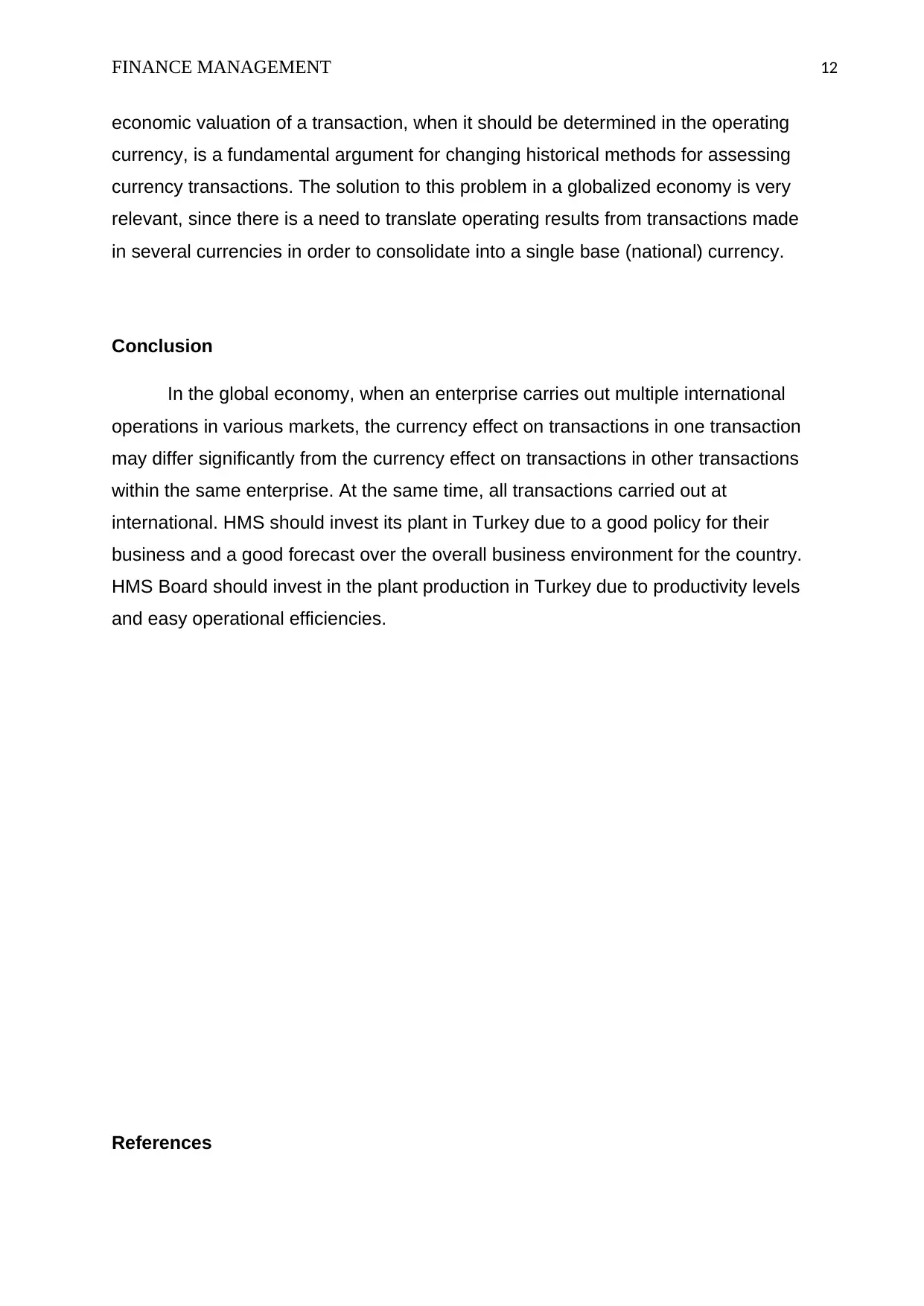
FINANCE MANAGEMENT 12
economic valuation of a transaction, when it should be determined in the operating
currency, is a fundamental argument for changing historical methods for assessing
currency transactions. The solution to this problem in a globalized economy is very
relevant, since there is a need to translate operating results from transactions made
in several currencies in order to consolidate into a single base (national) currency.
Conclusion
In the global economy, when an enterprise carries out multiple international
operations in various markets, the currency effect on transactions in one transaction
may differ significantly from the currency effect on transactions in other transactions
within the same enterprise. At the same time, all transactions carried out at
international. HMS should invest its plant in Turkey due to a good policy for their
business and a good forecast over the overall business environment for the country.
HMS Board should invest in the plant production in Turkey due to productivity levels
and easy operational efficiencies.
References
economic valuation of a transaction, when it should be determined in the operating
currency, is a fundamental argument for changing historical methods for assessing
currency transactions. The solution to this problem in a globalized economy is very
relevant, since there is a need to translate operating results from transactions made
in several currencies in order to consolidate into a single base (national) currency.
Conclusion
In the global economy, when an enterprise carries out multiple international
operations in various markets, the currency effect on transactions in one transaction
may differ significantly from the currency effect on transactions in other transactions
within the same enterprise. At the same time, all transactions carried out at
international. HMS should invest its plant in Turkey due to a good policy for their
business and a good forecast over the overall business environment for the country.
HMS Board should invest in the plant production in Turkey due to productivity levels
and easy operational efficiencies.
References
⊘ This is a preview!⊘
Do you want full access?
Subscribe today to unlock all pages.

Trusted by 1+ million students worldwide
1 out of 15
Related Documents
Your All-in-One AI-Powered Toolkit for Academic Success.
+13062052269
info@desklib.com
Available 24*7 on WhatsApp / Email
![[object Object]](/_next/static/media/star-bottom.7253800d.svg)
Unlock your academic potential
Copyright © 2020–2025 A2Z Services. All Rights Reserved. Developed and managed by ZUCOL.





